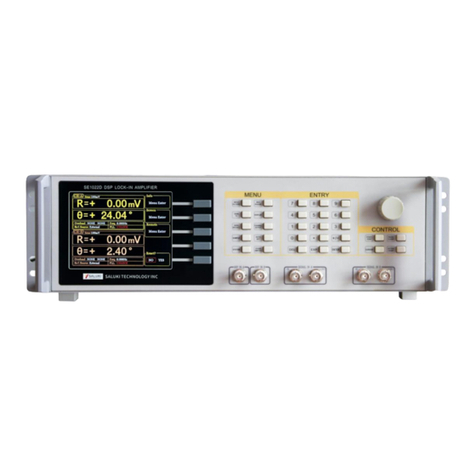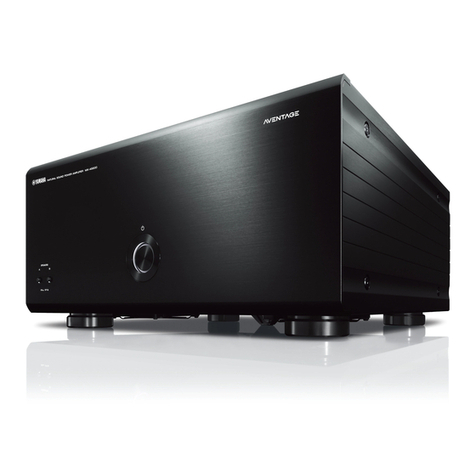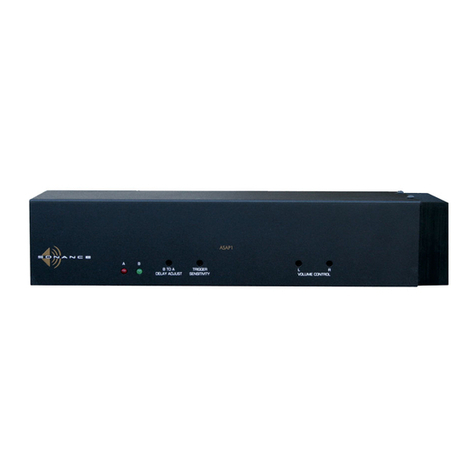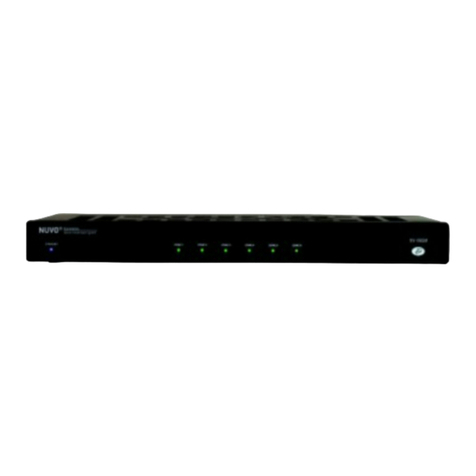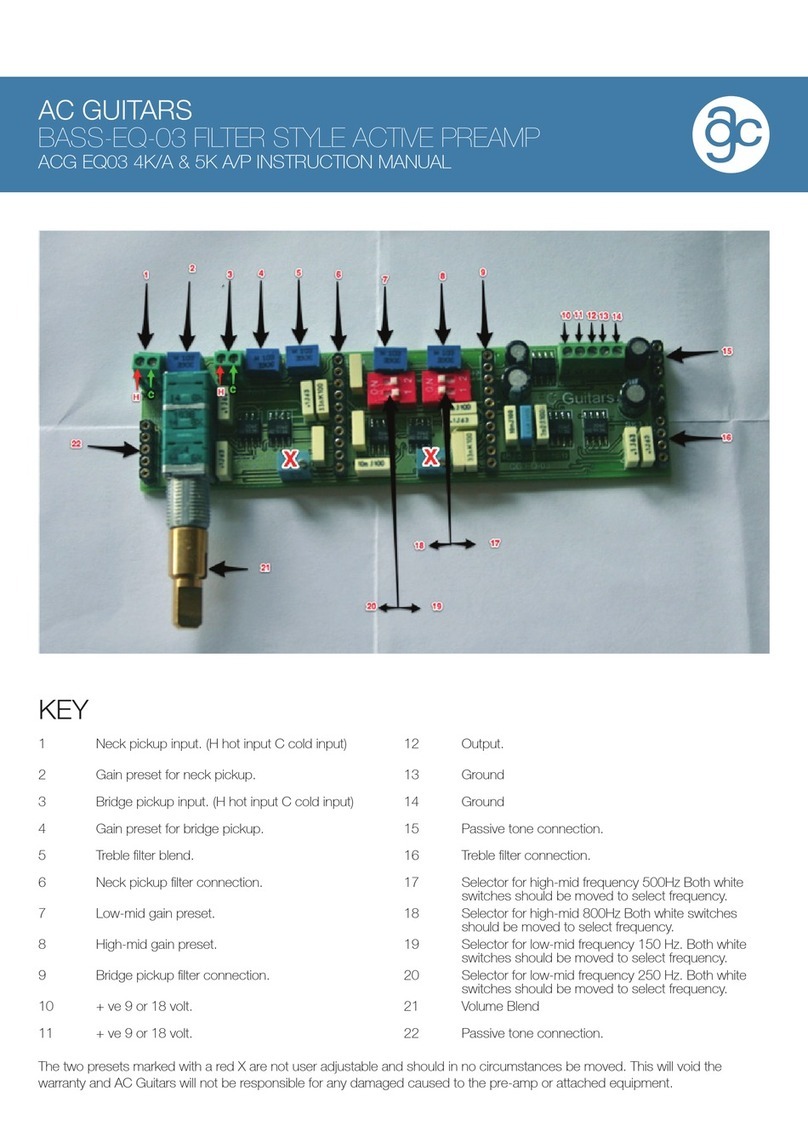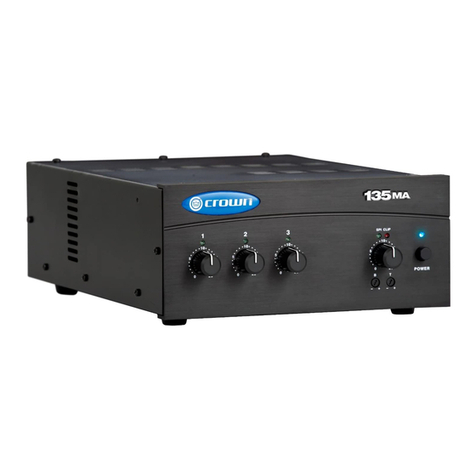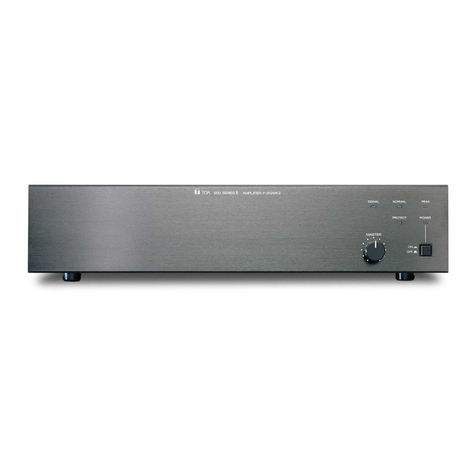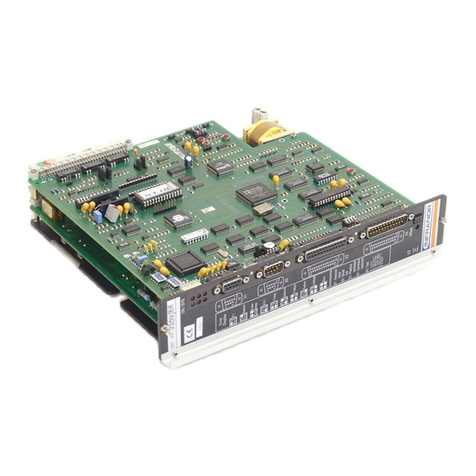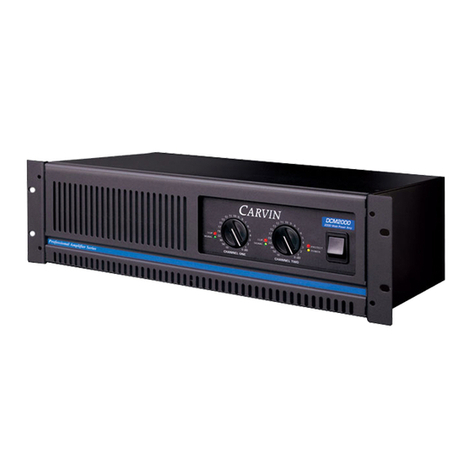Seeburg S Series User manual

Hardware Manual
S-Series
Version 1.0
06.10.2022

S-Series
1 Contents
2
1Contents
1Contents .......................................................................................................................... 2
2Foreword.......................................................................................................................... 3
3Safety Instructions & Installation................................................................................ 4
4Device Overview............................................................................................................. 5
4.1 Front Panel............................................................................................................................. 5
4.2 Rear Panel.............................................................................................................................. 6
5Operation......................................................................................................................... 7
5.1 Connections............................................................................................................................ 7
5.2 Start-up.................................................................................................................................... 7
5.3 Signal Flow Basics ................................................................................................................ 8
5.4 Using the User Interface....................................................................................................... 9
5.5 Display Pages ...................................................................................................................... 10
5.5.1 Overview Page.....................................................................................................................................10
5.5.2 Home Page...........................................................................................................................................11
5.5.3 DSP Page.............................................................................................................................................12
5.5.4 Tune Page ............................................................................................................................................13
5.5.5 EQ Page................................................................................................................................................14
5.5.6 Utility Page............................................................................................................................................15
6Technical Specifications............................................................................................. 19
7Declaration of Conformity .......................................................................................... 20

S-Series
2 Foreword
3
2Foreword
The four-channel S-Series system amplifiers cover a wide range of applications with a total output
of 2.5 to 20 kilowatts. They are able to drive high and low impedances and are therefore suitable
for both live applications and fixed installations.
The amplifiers are equipped with a high-quality 64-bit double-precision 96kHz FIR DSP and a
large, capacitive IPS touch display. The DSP contains a very extensive preset library for
SEEBURG loudspeakers. The user can also create their own presets for third-party products.
The S-Series can be fully operated and monitored remotely via Ethernet. Thanks to the integrated
network switch, the network connection can be passed on directly to the next device (daisy chain).
Analogue and digital (AES3) signals can be fed in via the XLR inputs. Optionally, audio over
Ethernet (AoE) signals can be processed via an AES67 interface (Dante™ compatible).
The wide-range switching power supplies allow operation on mains voltages from 90 to 265 volts.
They have an active power factor correction (PFC) and thus relieve the mains supply considerably.
Thanks to the latest generation of Class D topology, the power amplifiers achieve very high levels
of efficiency regardless of the load. They generate very little waste heat, which is dissipated to the
rear by a temperature-controlled, quiet fan. The already low idle power consumption can be re-
duced to below 5W by a remotely switchable standby mode.
The amplifier channels can drive low-impedance loads down to 2 ohms, as well as high-impedance
loads in 100V/70V/50V/35V lines. The advanced power management PCM™ provides the highest
possible output power on the individual channels until the capacity of the power supply is ex-
hausted.

S-Series
3 Safety Instructions & Installation
4
3Safety Instructions & Installation
ATTENTION!
The lightning symbol indicates the presence of possibly uninsulated,
dangerous voltages!
Read this manual before using the device!
When the appliance is installed, the plug inserted into the socket
outlet must be easily accessible.
The device must be earthed (via the mains plug).
Observe the professional association regulation BGV A2 –"Electrical
systems and equipment" or the equivalent of this regulation valid in
your country.
If necessary, observe any deviating regulations when using the de-
vice abroad.
The amplifier may only be connected to the loudspeakers by a spe-
cialist.
INSTALLATION NOTES
Note that the airflow to cool these devices is front-to-back.
Make sure that there are no objects on the front and back of the de-
vice that would impede the airflow and thus the correct functioning of
the cooling system.
Objects to the right and left of the device should be at least 2 centi-
meters away.

S-Series
4 Device Overview
5
4Device Overview
4.1 Front Panel
(1) Illuminated operating mode button:
Lights up as soon as mains voltage is present. Red: Device in standby, can be addressed
via Ethernet. Green: device in operation.
To switch the operating mode, hold down the button for one second.
(2) Touch Screen:
Display information and enter settings. See the Operation section of this manual.
(3) Push Encoder:
Navigation across the display areas, changing and entering settings.
(4) USB Socket:
For firmware updates and device control without Ethernet.

S-Series
4 Device Overview
6
4.2 Rear Panel
(1) Signal Input:
Neutrik® XLR sockets for analogue or digital (AES3) signals. Sockets 1 and 3 are used for
the two-channel AES3 signals.
(2) Signal Link:
Parallel XLR outputs for daisy-chaining the signal to other amplifiers.
(3) Loudspeaker Connectors:
Neutrik® SpeakOn™ receptacles for connecting the loudspeakers.
(4) Ethernet Ports:
2x RJ45-compatible Neutrik® EtherCon™ sockets for connecting to a network. With switch
for direct connection (daisy-chaining) to other amplifiers.
(5) Mains Connection:
Neutrik® PowerCon™ socket for connection of a 3-wire power cable according to local
regulations. Socket can be switched under load and has the function of a mains switch.
For fractions of a second, the amplifiers can draw peak currents far in
excess of what is listed under “Rated Current Consumption” in the
data table. We recommend operating the amplifiers on circuit break-
ers with C characteristics.

S-Series
5 Operation
7
5Operation
5.1 Connections
Connect the amplifier to a properly grounded AC 90-265V AC outlet.
The audio input signal can be either balanced or unbalanced.
Balanced signal: pin 1 ground, pin 2 positive signal (hot), pin 3 negative signal (cold).
Unbalanced signal: pin 1 ground, pin 2 signal, pin 3 ground.
ATTENTION: If you connect an unbalanced signal and pin 3 is not connected to the ground, this
creates a loss of 6dB signal level at the output!
5.2 Start-up
As soon as the mains supply is restored, the amplifier restores the last operating state. If the power
amplifier was previously in standby mode, this is restored - if the power amplifier was previously in
operation, it switches on again and uses the last settings made. This includes all loaded speaker
presets, level, mute, delay, EQ settings etc.
If the amplifier is in the standby state, it is switched on by pressing the operating mode button for at
least one second. Booting up takes only a few seconds and the last set values are restored.
If the amplifier is in operation, pressing the operating mode button for at least one second puts it
into standby mode. It can then only be addressed via Ethernet.

S-Series
5 Operation
8
5.3 Signal Flow Basics
The figure shows a configuration example of the amplifiers and in it the basic structure of the signal
flow from left (input) to right (output).
The physical hardware inputs are assigned to the sources, denoted by the lowercase letters a, b, c
and d. You can choose between analogue and digital inputs. For each input type, the number of
the hardware input is selected. For the XLR inputs, the number corresponds to the labeling on the
device: a1…a4 for analog or d1…d4 for AES3. Next, a source is assigned to the input path, denot-
ed by the capital letters A, B, Cand D. You can choose from the four individual sources as well as
the combinations a+b and c+d.
Each input path has a User EQ section. This provides six multimode filters, a high-pass filter, input
delay, input gain, polarity reversal and muting. The user can save all the settings made here as
presets on the device via the PC software for later use.
The Groups section that follows houses all the EQs, gains and delays added via the grouping
function in the PC software.
Finally, a speaker system is assigned to the path. The System preset contains all the basic cross-
over and protection functions, while the Mode EQ contains the settings specific to the respective
operating mode. In the case of multi-way speakers, the signal is output to the adjacent outputs.

S-Series
5 Operation
9
5.4 Using the User Interface
The power amplifiers are operated via a touch-sensitive color display and an endless encoder with
a push button function.
By touching the individual areas and "buttons" on the display, you can navigate directly to the re-
spective function. The selection of a function or an input field is highlighted by a blue border around
it.
If you touch a "mute button" it is selected and also switched simultaneously.
The encoder has two essential functions: navigation and value input. In the initial state it is in navi-
gation mode. As the encoder is turned, each function and “button” on the display is cycled through
in sequence, each highlighted by a blue border.
If the encoder is pressed (keyed), it switches to input mode (then the respective field is framed in
red) - or activates the function of the button (e.g. mute). If an input field is selected, the value of the
input field can be changed by turning the encoder. If a preset list is selected, it can be scrolled up
and down. Pressing the encoder again then loads the selected preset.
If no values are entered with the encoder for a while, it automatically switches back to navigation
mode.

S-Series
5 Operation
10
5.5 Display Pages
All essential device settings and information are shown on six display pages: Overview page,
Home page, DSP page, Tune page, EQ page and Utility page.
5.5.1 Overview Page
1 Device name, adjustable via the PC software
2 “Lock” button: To lock the control panel (display and encoder)
3 „Home“ button: To switch to the home screen.
4 Input Signal Indicator: Lights up green when signal is present.
5 Output Signal Indicator + “Mute” Button: Lights up green when signal is present, lights up
orange when the limiter is active and red when there is overload. Toggles between on and
mute (M) when pressed.
6 Snapshot: Shows the name of the currently loaded snapshot (device state)
7 Loaded speaker preset
8 Selected loudspeaker operating mode
9 Loudspeaker type or path
10 Display of the total set output signal levels
As soon as the power amplifier is controlled remotely from a PC via network or USB interface, the
color of the header changes from dark blue to gray. The “Lock” button lights up red and show the
inscription “OCS”. Whenever the amplifier is addressed via the software, this button flashes.

S-Series
5 Operation
11
5.5.2 Home Page
1 Output channel of the amplifier
2 ICL indicator: Lights up when the amplifier channels protection system is working
3 LIM meter: Shows the extent of the limitation (gain reduction) of the RMS and peak limiters
for the loaded loudspeaker
4 OUT meter: Indicates the output signal level relative to the full scale of the loaded loud-
speaker
5 T-Meter: Shows the temperature of the amplifier channels als a percentage
6 Output Signal Indicator: Lights up green when signal is present
7 “Mute” button: Mutes the output channel
8 Information panel about loaded speakers, operating modes, speaker type / way
9 Snapshot: Shows the name of the currently loaded snapshot (device state)
P1 Go to Overview page
P2 Go to DSP page
P3 Go to Tune page
P4 Go to Utility page
P5 Cancel entries, go to Home page

S-Series
5 Operation
12
5.5.3 DSP Page
1 Input source
2 Type of input: Selection menu (analog, AES3)
3 Hardware channel of the selected input: Selection menu (1...4)
4 Route In: Input source assigned to the path. Selection menu (a, b, c, d, a+b, c+d)
5 Name of the path: Editable via PC software
6 Group Values: Lights up green if group-wide parameters (EQ, Gain, Delay) are active.
Pressing the button resets all group-wide settings on the respective path
7 Loudspeaker: Selection menu for loading a loudspeaker (preset) from the internal library.
When loading multi-way loudspeakers, the amplifier channels on to the right are added to
this path.
8 M: Selection menu for the operating mode of the loaded speaker (e.g. Flat, HP, LP, Cardio,
etc.)
9 Way: Shows the speaker type or speaker way (e.g. Top, Sub, High, Mid, Low, etc.)
With single-channel loudspeakers, the path output is directly at the respective amplifier channels:
A=1, B=2, C=3, D=4. In the case of multi-way loudspeakers, the first path output is on the respec-
tive direct amplifier channel, the other loudspeaker ways are on the adjacent amplifier channels on
the right-hand side.
P1 Go to Home page
P2 Go to DSP page
P3 Go to Tune page
P4 Go to Utility page
P5 Cancel entries, go to Home page

S-Series
5 Operation
13
5.5.4 Tune Page
1 Input path name
2 User EQ: Lights green when the user equalizer is on. If a user EQ preset is loaded, the
name of the preset will appear. Pressing this button takes you to the EQ page.
3 In meter: Displays in input signal level of the path
4 Gain: Input box for adjusting the input level of the path
5 Delay: Input box for adjusting the input delay of the path. The entry is made in milliseconds
(ms). The automatically converted equivalent in meters and feet distance appears below.
6 MUTE: Path muting button. Lights up red when mute is active.
7 Pol: Button to activate the polarity reversal (“phase reversal”) of the path. Lights up orange
when the polarity is reversed.
With single-channel loudspeakers, the path output is directly at the respective amplifier channels:
A=1, B=2, C=3, D=4. In the case of multi-way loudspeakers, the direct amplifier channel is com-
bined with the adjacent amplifier channels on the right-hand side. This path then only has one User
EQ, one gain, one delay, etc.
P1 Go to Home page
P2 Go to DSP page
P3 Go to Tune page
P4 Go to Utility page
P5 Cancel entries, go to Home page

S-Series
5 Operation
14
5.5.5 EQ Page
1 Input path name
2 User EQ preset name. The preset contains all settings for the seven equalizer filters as
well as the set values for path gain and path delay
3 Filter on/off: Displays the status of each filter. Gray = filter off. Green = filter on. Tapping on
one of the filters selects it for editing. Its designation (HP, 1…6) then appears in red. Tap-
ping a selected filter again turns the filter on or off.
4 Type: Selection menu for assigning a filter type (PEQ, Shelving, Bandpass, Notch, etc.)
5 Freq: Input box for setting the filter (center) frequency
6 Gain: Input box for filter gain boost/cut (if applicable)
7 Q: Input box for setting the filter quality (if applicable).
8 EQ on/bypass: Shows the operating status of the filter section. Lights up green when the
filter section is on, gray when it is bypassed.
P1 Go to Home page
P2 Go to DSP page
P3 Go to Tune page
P4 Go to Utility page
P5 Cancel entries, go to Home page

S-Series
5 Operation
15
5.5.6 Utility Page
1 Information field about operating hours, serial number, loudspeaker library version, hard-
ware and firmware version. Loudspeaker libraries with version numbers ending in a 1 (e.g.
x.x1) contain phase linearization and time alignments. Version numbers ending in a 0 (e.g.
x.x0) do not include these features and are therefore compatible with HDLM8 and self-
powered speaker systems. The latest versions can be found in the download area of the
SEEBURG website.
2 Menu bar for calling up the Snapshot, Amplifier, Password, Ethernet and Reset tabs
3 Dimmer: Setting the brightness of the display
4 AutoDIM: Setting the waiting time until the display is automatically dimmed. The amplifier
remains in operation (operating mode button lights up green). As soon as the encoder is
operated, the display is switched on again.
5 AutoSLEEP: Setting the waiting time until the power amplifier automatically switches to
sleep mode. In Sleep mode, the amplifier channels are disabled. The sleep mode is auto-
matically ended within 10 milliseconds when an audio signal is present at the inputs.
6 AutoStBy: Setting the waiting time until the power amplifier automatically switches to
standby mode. The standby mode is automatically ended within 2 seconds when audio
signal is present on the inputs.
P1 Go to Home page
P2 Go to DSP page
P3 Go to Tune page
P4 Go to Utility page
P5 Cancel entries, go to Home page

S-Series
5 Operation
16
5.5.6.1 Snapshot Tab
1 Save to Lib: Saves the current device state (i.e. all currently set parameters) to a snapshot
slot on the device. This can be an empty one or one with an existing preset to be overwrit-
ten.
2 Recall from Lib: Loads a snapshot previously saved on the device.
3 Delete Snapshot Memory: Deletes all snapshots (empties all memory slots) on the device..
5.5.6.2 Amplifier Tab
1 Gain: Allows adjustment of the nominal power amp gain in the range of 26dB to 44dB. The
default value is 32dB. This setting has no effect on the limiter thresholds set in the speaker
presets.
2 LZ/HZ: Allows switching between low-impedance operation (“Low Z”is set by default) and
operation on 35V, 50V, 70V and 100V lines.
3 0 dBFS IN: Allows adjustment of the reference level of the digital audio inputs (AES3) or
network audio inputs (AES67) if they are installed.

S-Series
5 Operation
17
5.5.6.3 Password Tab
1 General Password: To activate it, you need to enter and confirm a 4-digit code. If the pro-
tection is activated, access to the amplifier via the control panel and the PC software is re-
stricted.
5.5.6.4 Ethernet Tab
1 Static IP Shows the currently set IP address of the device, editable in manual mode.
2 SubNet Mask: Shows the currently set subnet mask of the device. Editable in manual
mode.
3 "AUTO IP" button: Activates the automatic address assignment and then lights up red. If
there is a DHCP server in the network, the address will be assigned by it. If no DHCP is
available, the automatic self-assignment of an IP address takes place according to the
Zero Configuration Networking Protocol (Zeroconf).
4 "Apply IP Settings" button: Applies the IP/subnet values set in manual mode.

S-Series
5 Operation
18
5.5.6.5 Reset Tab
1 “Process Reset" button resets all parameters and processing of the amplifier to their de-
fault state. All settings made and loaded presets are reset. The preset libraries, snapshots,
EQ presets stored on the device are retained.

S-Series
6 Technical Specifications
19
6Technical Specifications
The technical data sheet and further information about possible applications and accessories can
be found on the Internet at www.seeburg.com.

S-Series
7 Declaration of Conformity
20
7Declaration of Conformity
EC Declaration of Conformity
For the products
S3
S5
S10
S20
it is hereby confirmed that they comply with the regulations of the following EU directives including
any supplements:
2006/95/EG, Low Voltage
2004/108/EG, Electromagnetic Compatibility
(References: Apendix 1, paragraph 1, a and b)
The following standards were applied:
DIN EN 60065
DIN EN 55103-1:1996, classes E1 to E4
DIN EN 55103-2:1996, classes E1 to E4
Issuer of this declaration: Winfried Seeburg, SEEBURG acoustic line GmbH
Place, Date: Senden, 01.06.2022
Authorized signature: ____________________________________________
The appendices are part of this declaration. This declaration certifies compliance with the guide-
lines mentioned, but does not include any guarantee of properties. The safety instructions in the
supplied product documentation must be observed.
SEEBURG acoustic line Produktions- und Vertriebsgesellschaft mbH
Auweg 32
89250 Senden, GERMANY
+49 7307 / 9700 –0
This manual suits for next models
8
Table of contents
Other Seeburg Amplifier manuals
Popular Amplifier manuals by other brands

Phoenix Gold
Phoenix Gold Tantrum 200.2 manual

Tugicom
Tugicom AMP300A user manual
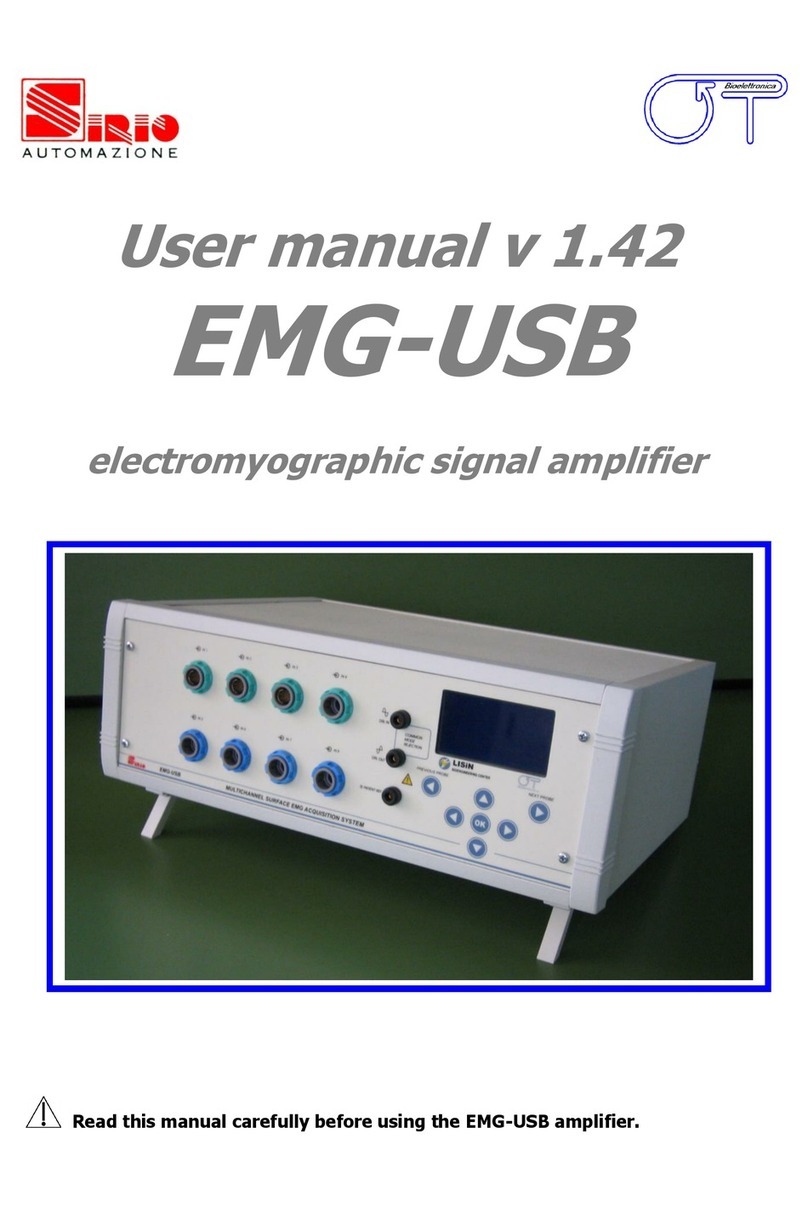
Sirio Antenne
Sirio Antenne OT Bioelettronica EMG-USB user manual

Zed Audio
Zed Audio Draconia Instruction & installation manual

Conrad-johnson design
Conrad-johnson design PREMIER 15 owner's manual

Woo Audio
Woo Audio WA5 owner's manual

